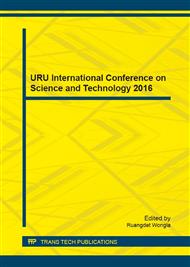p.3
p.9
p.15
p.22
p.26
p.31
p.37
p.42
p.47
Synthesis and Study of Naphthoquinones Derivatives
Abstract:
In this research, we reported the study and synthesis of naphthoquinones intermediate compounds lead to the target naphthoquinones derivatives product. Naphthoquinones derivatives have long been known to display anticancer and antimalarial activity in addition to a wide variety of other bioactivities. Moreover, it has been reported to possess antimalarial disease against Plasmodium falciparum. The naphthoquinones derivatives product (5) were synthesized by coupling with 2-(3-bromo-2,2-dimethylpropyl)-1-methoxynaphthalene (4) and methyl ketone fatty acid (3). The 2-(3-bromo-2,2-dimethylpropyl)-1-methoxynaphthalene (4) was constructed by 1-hydroxy-2-naphthoic acid (1) in 5 steps with good to excellent yield. The synthetic pathway was started with the methylation provided the methyl ester naphthoquinones compound in 93% yields. Then, the reduction of methyl ketone by using LiAlH4 gave the alcohol compound in 90% yields. Methyl alcohol was changed to the alkyl bromide using PBr3 in 75% yield. The alkylation reaction between compound and methyl isobutyl ketone by LDA as a catalyst provided the methyl ester compound followed by reduction using LiAlH4 obtained the alcohol compound in 44% yield. The bromo-product core structure (2) was produced by using PBr3 in 82%. Most of intermediate compounds were characterized by 1H and 13C NMR spectroscopy technique. The substitution reaction will be carried out by methyl ketone (3) as an efficient condensing agent leading to gem-dimethyl fatty acid naphthoquinones product (5) in Figures 1. Finally, the synthetic route utilizing hydroxy-1,4-napthoquinones in 3 steps is being explored.
Info:
Periodical:
Pages:
26-30
Citation:
Online since:
October 2016
Permissions:
Share:
Citation:


